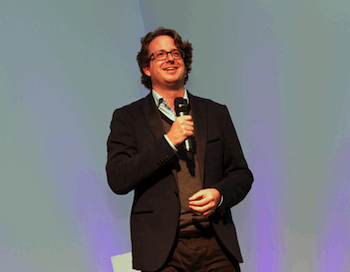San Francisco, CA--Sennheiser has announced the official opening of its San Francisco-based research lab: SFTC (Technology and Innovation California).
- Daniel Sennheiser, president strategy and finance, Sennheiser, makes comments to attendees during the official opening party of the SFTC on January 18, 2012 (photo credit: FatimataVetu).
- The opening ceremony was attended by more then 100 guests from the audio community in the Bay Area. The new research facility - which relocated from Palo Alto in November 2011, is focused on improving the customer experience through digital signal processing (DSP) technologies and combining this with Sennheiser's expertise in electro-acoustics and wireless transmission.
- As a research hub for Sennheiser, whose slogan is "The Future Made Right Here," SFTC creates knowledge in selected areas of DSP and facilitates knowledge transfer to Sennheiser's product teams around the world. Many of these ideas and technologies are then adopted and integrated into Sennheiser's consumer, professional or installed sound divisions.
- "The Sennheiser culture has always been rooted in innovation and exploring what may be possible in the future," said Daniel Sennheiser, president strategy and finance, Sennheiser. "Our new facility in San Francisco leverages an extensive ecosystem of talents that includes not only our own visionary thinkers and researchers, but world renowned academic institutions and corporations. In this environment, our engineers are free to experiment and play with technology and processes that may eventually find its way into various consumer, pro and installed sound applications."
- After it finishes developing and testing a concept, Sennheiser may choose to introduce a prototype model to test its market value and gauge end-user interest. Last year at the prolight+sound and NAMM trade shows, Sennheiser unveiled a project that was under development at its SFTC research laboratory: "Concept Tahoe."
- This wireless microphone prototype is not only able to function as a high quality, professional wireless microphone, but also as an effects and processing controller. This functionality is facilitated by the transmission of control data to a receiver, which can control any number of effects or plug-ins in real time using the MIDI protocol. The microphone can also be transformed into a tambourine or a shaker at the press of a button. By using an accelerometer and a rotation sensor, it measures how quickly it is moving and at what angle in space it is currently located. This prototype was demonstrated during the SFTC opening event, and showcased by beatboxer entertainers Butterscotch and Eklips.
- "By moving the location of the SFTC to the Bay Area, our team - and by extension the entire Sennheiser organization - is able to leverage our proximity to the technology industry's leading innovators, product designers and thought leaders. These include other multi-national companies as well as a unique network of start-ups and highly regarded institutions such as UC Berkeley and Stanford University," said Veronique Larcher, director of research, North America, for Sennheiser. "At SFTC, our researchers have access to an enormous pool of talent and imagination; risk taking and the cross-fertilization of ideas is strongly encouraged."
- Sennheiser launched its SFTC in 2006 and since then, its research and development work have been manifested in Sennheiser's groundbreaking products - including the IS-ADN conference system.










